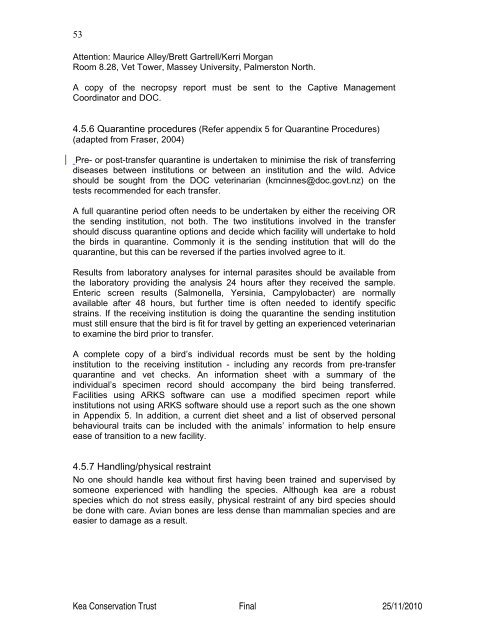(Nestor notabilis) Husbandry Manual - Kea Conservation Trust
(Nestor notabilis) Husbandry Manual - Kea Conservation Trust
(Nestor notabilis) Husbandry Manual - Kea Conservation Trust
Create successful ePaper yourself
Turn your PDF publications into a flip-book with our unique Google optimized e-Paper software.
53<br />
Attention: Maurice Alley/Brett Gartrell/Kerri Morgan<br />
Room 8.28, Vet Tower, Massey University, Palmerston North.<br />
A copy of the necropsy report must be sent to the Captive Management<br />
Coordinator and DOC.<br />
4.5.6 Quarantine procedures (Refer appendix 5 for Quarantine Procedures)<br />
(adapted from Fraser, 2004)<br />
Pre- or post-transfer quarantine is undertaken to minimise the risk of transferring<br />
diseases between institutions or between an institution and the wild. Advice<br />
should be sought from the DOC veterinarian (kmcinnes@doc.govt.nz) on the<br />
tests recommended for each transfer.<br />
A full quarantine period often needs to be undertaken by either the receiving OR<br />
the sending institution, not both. The two institutions involved in the transfer<br />
should discuss quarantine options and decide which facility will undertake to hold<br />
the birds in quarantine. Commonly it is the sending institution that will do the<br />
quarantine, but this can be reversed if the parties involved agree to it.<br />
Results from laboratory analyses for internal parasites should be available from<br />
the laboratory providing the analysis 24 hours after they received the sample.<br />
Enteric screen results (Salmonella, Yersinia, Campylobacter) are normally<br />
available after 48 hours, but further time is often needed to identify specific<br />
strains. If the receiving institution is doing the quarantine the sending institution<br />
must still ensure that the bird is fit for travel by getting an experienced veterinarian<br />
to examine the bird prior to transfer.<br />
A complete copy of a bird’s individual records must be sent by the holding<br />
institution to the receiving institution - including any records from pre-transfer<br />
quarantine and vet checks. An information sheet with a summary of the<br />
individual’s specimen record should accompany the bird being transferred.<br />
Facilities using ARKS software can use a modified specimen report while<br />
institutions not using ARKS software should use a report such as the one shown<br />
in Appendix 5. In addition, a current diet sheet and a list of observed personal<br />
behavioural traits can be included with the animals’ information to help ensure<br />
ease of transition to a new facility.<br />
4.5.7 Handling/physical restraint<br />
No one should handle kea without first having been trained and supervised by<br />
someone experienced with handling the species. Although kea are a robust<br />
species which do not stress easily, physical restraint of any bird species should<br />
be done with care. Avian bones are less dense than mammalian species and are<br />
easier to damage as a result.<br />
<strong>Kea</strong> <strong>Conservation</strong> <strong>Trust</strong> Final 25/11/2010












